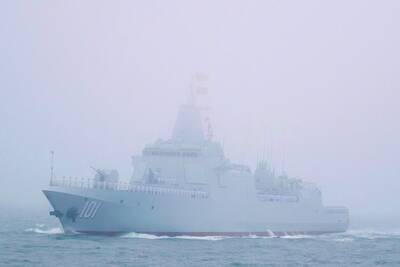Scientists have unearthed in New Zealand fossil bones of what might be the heavyweight champion of the penguin world, a bird about 1.77m tall that thrived 55 million to 60 million years ago, relatively soon after the demise of the dinosaurs.
Researchers on Tuesday said that the ancient penguin, called Kumimanu biceae, weighed nearly 101kg and was much bigger than the largest of these flightless seabirds alive today, the emperor penguin, which grows to about 1.2m and weighs about 40kg.
The only ancient penguin yet discovered that might have been larger than Kumimanu is known only from a leg bone, said ornithologist Gerald Mayr of the Senckenberg Research Institute and Natural History Museum Frankfurt in Germany.

Photo: AP
“Gigantism in penguins evolved more than once,” Mayr said.
Kumimanu, named after a creature from Maori folklore and the Maori word for bird, is the second-oldest known penguin. The older one, also from New Zealand, was 61 million years old.
Kumimanu’s partial skeleton lacks the skull.
Mayr said other fossils indicate that the earliest penguins possessed much longer beaks than their modern relatives, useful for spearing fish.
“It would have been very impressive: as tall as many people and a very solid, muscly animal built to withstand frequent deep dives to catch its prey,” said Alan Tennyson, vertebrate curator at the Museum of New Zealand Te Papa Tongarewa, one of the researchers in the study published in the journal Nature Communications.
“It would not have been the kind of bird that someone could catch alive. It would have been considerably more powerful than a person,” he added.
Kumimanu and other early penguins had already developed typical penguin features including flipper-like wings and an upright stance.
Studies suggest early penguins were brownish, not the trademark black and white of today’s penguins, Mayr said.
Penguins are thought to have evolved from a flying ancestor perhaps resembling a cormorant, Mayr said.
The asteroid that doomed the dinosaurs 66 million years ago also eliminated the large marine reptiles that dominated the seas, clearing the way for fish-eating divers like penguins.

END OF AN ERA: The vote brings the curtain down on 20 years of socialist rule, which began in 2005 when Evo Morales, an indigenous coca farmer, was elected president A center-right senator and a right-wing former president are to advance to a run-off for Bolivia’s presidency after the first round of elections on Sunday, marking the end of two decades of leftist rule, preliminary official results showed. Bolivian Senator Rodrigo Paz was the surprise front-runner, with 32.15 percent of the vote cast in an election dominated by a deep economic crisis, results published by the electoral commission showed. He was followed by former Bolivian president Jorge “Tuto” Quiroga in second with 26.87 percent, according to results based on 92 percent of votes cast. Millionaire businessman Samuel Doria Medina, who had been tipped

ELECTION DISTRACTION? When attention shifted away from the fight against the militants to politics, losses and setbacks in the battlefield increased, an analyst said Recent clashes in Somalia’s semi-autonomous Jubaland region are alarming experts, exposing cracks in the country’s federal system and creating an opening for militant group al-Shabaab to gain ground. Following years of conflict, Somalia is a loose federation of five semi-autonomous member states — Puntland, Jubaland, Galmudug, Hirshabelle and South West — that maintain often fractious relations with the central government in the capital, Mogadishu. However, ahead of elections next year, Somalia has sought to assert control over its member states, which security analysts said has created gaps for al-Shabaab infiltration. Last week, two Somalian soldiers were killed in clashes between pro-government forces and

Ten cheetah cubs held in captivity since birth and destined for international wildlife trade markets have been rescued in Somaliland, a breakaway region of Somalia. They were all in stable condition despite all of them having been undernourished and limping due to being tied in captivity for months, said Laurie Marker, founder of the Cheetah Conservation Fund, which is caring for the cubs. One eight-month-old cub was unable to walk after been tied up for six months, while a five-month-old was “very malnourished [a bag of bones], with sores all over her body and full of botfly maggots which are under the

BRUSHED OFF: An ambassador to Australia previously said that Beijing does not see a reason to apologize for its naval exercises and military maneuvers in international areas China set off alarm bells in New Zealand when it dispatched powerful warships on unprecedented missions in the South Pacific without explanation, military documents showed. Beijing has spent years expanding its reach in the southern Pacific Ocean, courting island nations with new hospitals, freshly paved roads and generous offers of climate aid. However, these diplomatic efforts have increasingly been accompanied by more overt displays of military power. Three Chinese warships sailed the Tasman Sea between Australia and New Zealand in February, the first time such a task group had been sighted in those waters. “We have never seen vessels with this capability